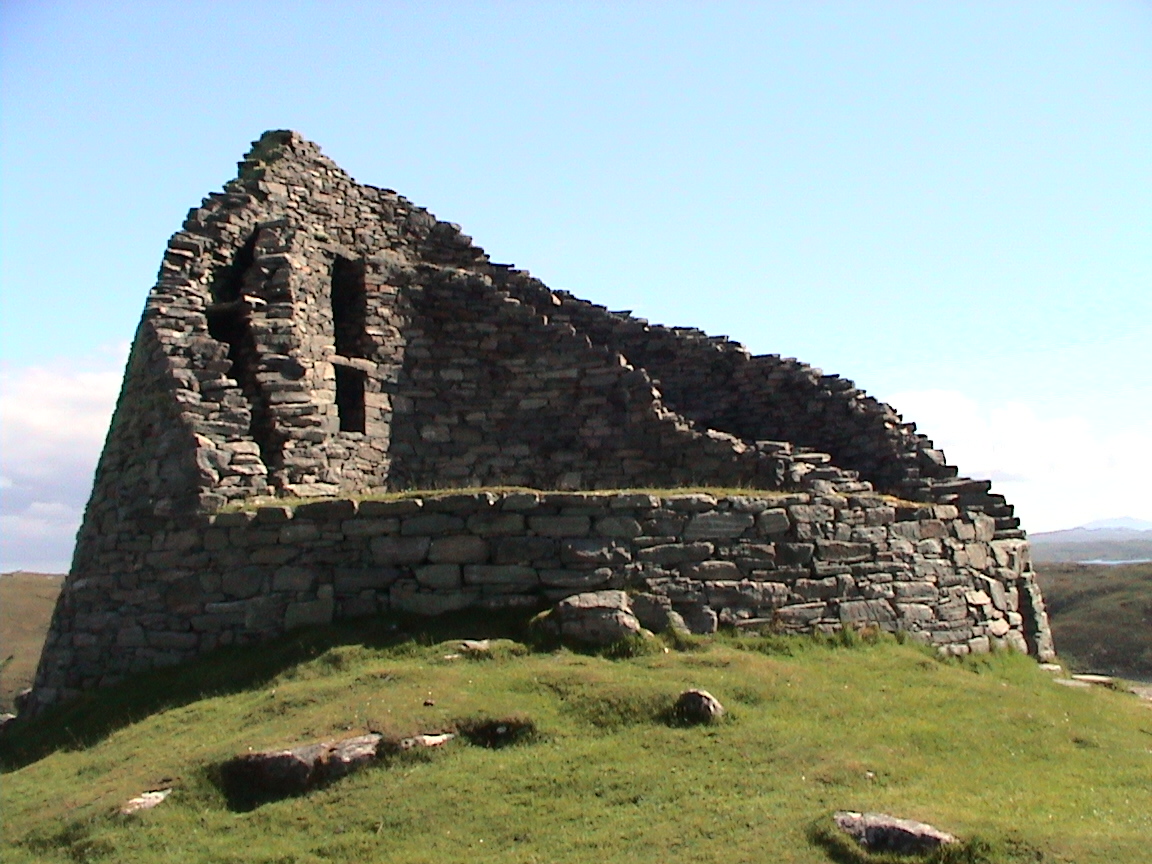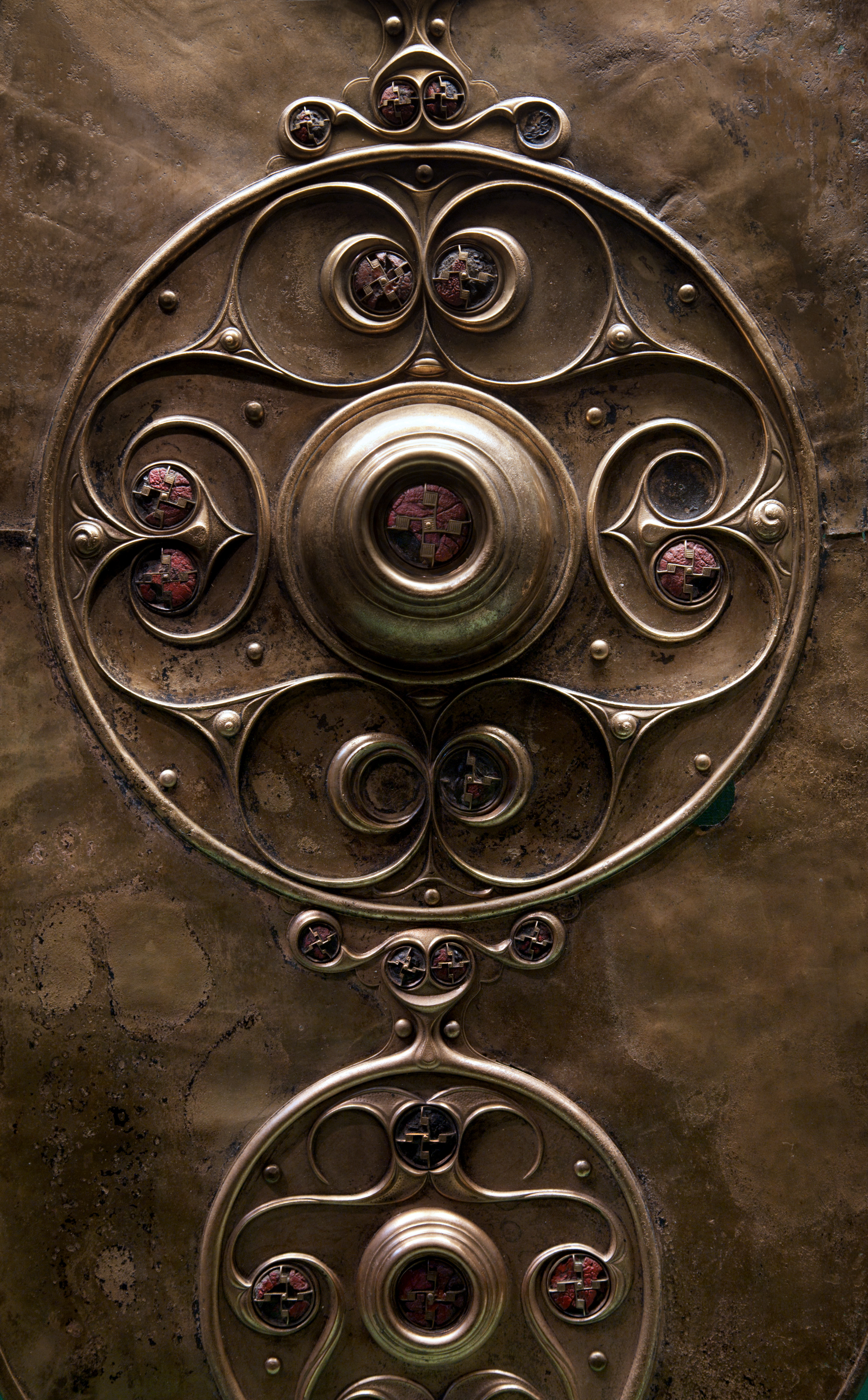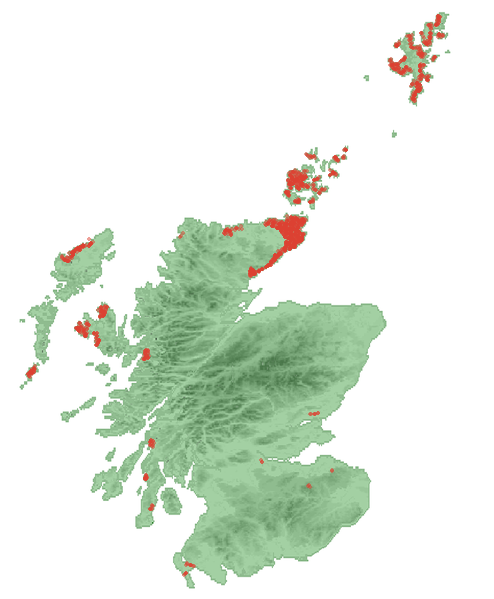|
Clumlie Broch
Clumlie Broch is an Iron Age broch located on Mainland, Shetland, in Scotland (). Location Clumlie Broch is located in Dunrossness, on the southern part of Mainland, Shetland about 8 kilometres north of Sumburgh Airport. It stands on a low rise on flat arable ground. The broch is at the centre of an abandoned croft, which encroaches upon the ruins. Description The broch has an external diameter of 21 metres and an internal diameter of about 8 metres. Much of the western side of the site is hidden by a stone dyke, but the entrance passage and a guard cell are visible. The walls currently stand around 2 metres high. Excavations Clumlie Broch was partially excavated by Gilbert Goudie in 1887, who also restored part of the walling. Goudie discovered a stone cist 75 centimetres above the floor of the broch and concluded that the broch had been used for burials after it had fallen into disuse. Finds included stone implements, quern stones, whetstones, spindle whorl A spindle whor ... [...More Info...] [...Related Items...] OR: [Wikipedia] [Google] [Baidu] |
Mainland, Shetland
The Mainland is the main island of Shetland, Scotland. The island contains Shetland's only burgh, Lerwick, and is the centre of Shetland's ferry and air connections. Geography It has an area of , making it the third-largest Scottish island and the fifth largest of the British Isles after Great Britain, Ireland, Lewis and Harris and Skye. Mainland is the second most populous of the Scottish islands (only surpassed by Lewis and Harris), and had 18,765 residents in 2011 compared to 17,550 in 2001. The mainland can be broadly divided into four sections: *The long southern peninsula, south of Lerwick, has a mixture of moorland and farmland and contains many important archaeological sites. ** Bigton, Cunningsburgh, Sandwick, Scalloway, and Sumburgh *The Central Mainland has more farmland and some woodland plantations. *The West Mainland ** Aith, Walls, and Sandness *The North Mainland – in particular the large Northmavine peninsula, connected to Mainland by a narrow isthm ... [...More Info...] [...Related Items...] OR: [Wikipedia] [Google] [Baidu] |
Broch
A broch is an Iron Age drystone hollow-walled structure found in Scotland. Brochs belong to the classification "complex Atlantic roundhouse" devised by Scottish archaeologists in the 1980s. Their origin is a matter of some controversy. Origin and definition The word ''broch'' is derived from Lowland Scots 'brough', meaning (among other things) fort. In the mid-19th century Scottish antiquaries called brochs 'burgs', after Old Norse ', with the same meaning. Place names in Scandinavian Scotland such as Burgawater and Burgan show that Old Norse ' is the older word used for these structures in the north. Brochs are often referred to as '' duns'' in the west. Antiquarians began to use the spelling ''broch'' in the 1870s. A precise definition for the word has proved elusive. Brochs are the most spectacular of a complex class of roundhouse buildings found throughout Atlantic Scotland. The Shetland Amenity Trust lists about 120 sites in Shetland as candidate brochs, while the ... [...More Info...] [...Related Items...] OR: [Wikipedia] [Google] [Baidu] |
British Iron Age
The British Iron Age is a conventional name used in the archaeology of Great Britain, referring to the prehistoric and protohistoric phases of the Iron Age culture of the main island and the smaller islands, typically excluding prehistoric Ireland, which had an independent Iron Age culture of its own. The parallel phase of Irish archaeology is termed the Irish Iron Age. The Iron Age is not an archaeological horizon of common artefacts but is rather a locally-diverse cultural phase. The British Iron Age followed the British Bronze Age and lasted in theory from the first significant use of iron for tools and weapons in Britain to the Romanisation of the southern half of the island. The Romanised culture is termed Roman Britain and is considered to supplant the British Iron Age. The tribes living in Britain during this time are often popularly considered to be part of a broadly- Celtic culture, but in recent years, that has been disputed. At a minimum, "Celtic" is a lingui ... [...More Info...] [...Related Items...] OR: [Wikipedia] [Google] [Baidu] |
Broch
A broch is an Iron Age drystone hollow-walled structure found in Scotland. Brochs belong to the classification "complex Atlantic roundhouse" devised by Scottish archaeologists in the 1980s. Their origin is a matter of some controversy. Origin and definition The word ''broch'' is derived from Lowland Scots 'brough', meaning (among other things) fort. In the mid-19th century Scottish antiquaries called brochs 'burgs', after Old Norse ', with the same meaning. Place names in Scandinavian Scotland such as Burgawater and Burgan show that Old Norse ' is the older word used for these structures in the north. Brochs are often referred to as '' duns'' in the west. Antiquarians began to use the spelling ''broch'' in the 1870s. A precise definition for the word has proved elusive. Brochs are the most spectacular of a complex class of roundhouse buildings found throughout Atlantic Scotland. The Shetland Amenity Trust lists about 120 sites in Shetland as candidate brochs, while the ... [...More Info...] [...Related Items...] OR: [Wikipedia] [Google] [Baidu] |
Dunrossness
Dunrossness, (Old Norse: ''Dynrastarnes'' meaning "headland of the loud tide-race", referring to the noise of Sumburgh Roost) is the southernmost parish of Shetland, Scotland. Historically the name Dunrossness has usually referred to the area on the Shetland mainland south of Quarff. However, in 2016 there were three separate Shetland Community Councils for a) Gulberwick, Quarff and Cunningsburgh; b) Sandwick; and c) Dunrossness. The 2011 census defined Dunrossness as including everybody within the British ZE2 postal code, which goes as far north as Gulberwick. It has the best and largest area of fertile farmland of any parish in Shetland. Dunrossness includes the island of Mousa, Levenwick, St Ninian's Isle, Bigton, Scousburgh, the Lochs of Spiggie and Brow, Boddam, Quendale, Virkie, Exnaboe, Grutness, Toab, Ness of Burgi, Clumlie Broch, Scatness, Sumburgh Airport, Sumburgh Head, West Voe, the islands of Lady's Holm, Little Holm, Horse Holm island and Fai ... [...More Info...] [...Related Items...] OR: [Wikipedia] [Google] [Baidu] |
Sumburgh Airport
Sumburgh Airport is the main airport serving Shetland in Scotland. It is located on the southern tip of the mainland, in the parish of Dunrossness, south of Lerwick. The airport is owned by Highlands and Islands Airports Limited (HIAL) and served by Loganair. On 1 April 1995, ownership of the Company transferred from the UK Civil Aviation Authority to the Secretary of State for Scotland and subsequently to the Scottish Ministers. HIAL receives subsidies from the Scottish Ministers in accordance with Section 34 of the Civil Aviation Act 1982 and is sponsored by Transport Scotland which is an Executive Agency of the Scottish Government and accountable to Scottish Ministers. History Sumburgh Links was surveyed and the grass strips laid out by Captain E. E. Fresson of Highland Airways in 1936: the airport was opened on 3 June of that year with the inaugural flight from Aberdeen (Kintore) by the De Havilland Dragon Rapide G-ACPN piloted by Fresson himself. It was also one o ... [...More Info...] [...Related Items...] OR: [Wikipedia] [Google] [Baidu] |
Cist
A cist ( or ; also kist ; from grc-gre, κίστη, Middle Welsh ''Kist'' or Germanic ''Kiste'') is a small stone-built coffin-like box or ossuary used to hold the bodies of the dead. Examples can be found across Europe and in the Middle East. A cist may have been associated with other monuments, perhaps under a cairn or long barrow. Several cists are sometimes found close together within the same cairn or barrow. Often ornaments have been found within an excavated cist, indicating the wealth or prominence of the interred individual. This old word is preserved in the Nordic languages as "" in Swedish and "" in Danish and Norwegian, where it is the word for a funerary coffin. In English it is related to "cistern".''cistern'' Regional examples ;Sri Lanka * Bellanbedipalassa * Pothana * Ibbankatuwa Megalithic Stones * Udaranchamadama ;England * Bellever Forest, Dartmoor * Hepburn woods, Northumberland ;Estonia * Jõelähtme (Rebala) stone-cist graves, Harju County ;Gu ... [...More Info...] [...Related Items...] OR: [Wikipedia] [Google] [Baidu] |
Quern-stone
Quern-stones are stone tools for hand- grinding a wide variety of materials. They are used in pairs. The lower stationary stone of early examples is called a saddle quern, while the upper mobile stone is called a muller, rubber or handstone. The upper stone was moved in a back-and-forth motion across the saddle quern. Later querns are known as rotary querns. The central hole of a rotary quern is called the eye, and a dish in the upper surface is known as the hopper. A handle slot contained a handle which enabled the rotary quern to be rotated. They were first used in the Neolithic era to grind cereals into flour. Uses of quern-stones An old Gaelic proverb is "The quern performs best when the grindstone has been pitted." Design of quern-stones The upper stones were usually concave while the lower ones were convex. Quern-stones are frequently identifiable by their grooved working surfaces which enabled the movement of flour. Sometimes a millrind was present as a piece of wood (or ... [...More Info...] [...Related Items...] OR: [Wikipedia] [Google] [Baidu] |
Sharpening Stone
Sharpening stones, or whetstones, are used to sharpen the edges of steel tools such as knives through grinding and honing. Such stones come in a wide range of shapes, sizes, and material compositions. They may be flat, for working flat edges, or shaped for more complex edges, such as those associated with some wood carving or woodturning tools. They may be composed of natural quarried material or from man-made material. They come in various grades, which refer to the grit size of the abrasive particles in the stone. (Grit size is given as a number, which indicates the spatial density of the particles; a higher number denotes a higher density and therefore smaller particles, which give a finer finish to the surface of the sharpened object.) Stones intended for use on a workbench are called bench stones, while small, portable ones, whose size makes it hard to draw large blades uniformly over them, especially “in the field,” are called pocket stones. Often whetstones are u ... [...More Info...] [...Related Items...] OR: [Wikipedia] [Google] [Baidu] |
Spindle Whorl
A spindle whorl is a disc or spherical object fitted onto the spindle to increase and maintain the speed of the spin. Historically, whorls have been made of materials like amber, antler, bone, ceramic, coral, glass, stone, metal (iron, lead, lead alloy), and wood ( oak). Local sourced materials have been also used, such as chalk, limestone, mudstone, sandstone, slate, lydite and soapstone. Gallery File:Spindle Whorl (Sulsultin), 19th century, 05.588.7382.jpg, ''Spindle Whorl (Sulsultin)'', Chemainus, Coast Salish (Native American), 19th century, Brooklyn Museum File:Przęślik 0211.jpg, Whorl (12th or 13th century) found in Poland File:1017_-_Keramikos_Museum,_Athens_-_Spindle-whirls,_10th_century_BC_-_Photo_by_Giovanni_Dall'Orto,_Nov_12.jpg, Ancient Greek spindle whorls, 10th century BC, Kerameikos Archaeological Museum, Athens File:Muisca spindle whorl.jpg, Muisca spindle whorl (500AD – 1500AD). Archaeology Museum, Sogamoso, Colombia File:Object from the exhibition We c ... [...More Info...] [...Related Items...] OR: [Wikipedia] [Google] [Baidu] |
Hammerstone
In archaeology, a hammerstone is a hard cobble used to strike off lithic flakes from a lump of tool stone during the process of lithic reduction. The hammerstone is a rather universal stone tool which appeared early in most regions of the world including Europe, India and North America. This technology was of major importance to prehistoric cultures before the age of metalworking. Materials A hammerstone is made of a material such as sandstone, limestone or quartzite, is often ovoid in shape (to fit the human hand better), and develops telltale battering marks on one or both ends. In archaeological recovery, hammerstones are often found in association with other stone tool artifacts, debitage and/or objects of the hammer such as ore. The modern use of hammerstones is now mostly limited to flintknappers and others who wish to develop a better understanding of how stone tools were made. Usage Hammerstones are or were used to produce flakes and hand axes as well as ... [...More Info...] [...Related Items...] OR: [Wikipedia] [Google] [Baidu] |
Brochs In Shetland
A broch is an Iron Age drystone hollow-walled structure found in Scotland. Brochs belong to the classification "complex Atlantic roundhouse" devised by Scottish archaeologists in the 1980s. Their origin is a matter of some controversy. Origin and definition The word ''broch'' is derived from Lowland Scots 'brough', meaning (among other things) fort. In the mid-19th century Scottish antiquaries called brochs 'burgs', after Old Norse ', with the same meaning. Place names in Scandinavian Scotland such as Burgawater and Burgan show that Old Norse ' is the older word used for these structures in the north. Brochs are often referred to as ''duns'' in the west. Antiquarians began to use the spelling ''broch'' in the 1870s. A precise definition for the word has proved elusive. Brochs are the most spectacular of a complex class of roundhouse buildings found throughout Atlantic Scotland. The Shetland Amenity Trust lists about 120 sites in Shetland as candidate brochs, while the Royal Co ... [...More Info...] [...Related Items...] OR: [Wikipedia] [Google] [Baidu] |



_1934.jpg)



